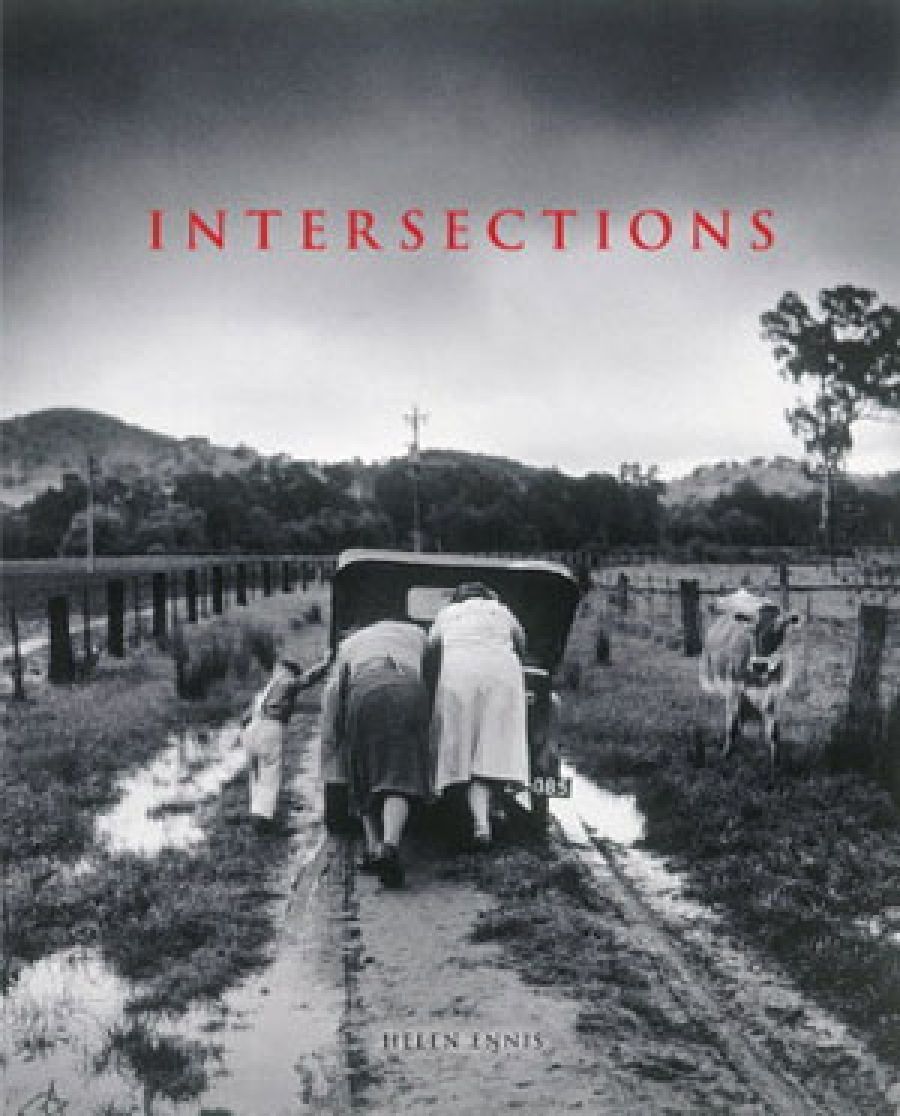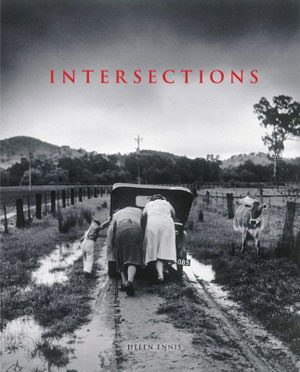
- Free Article: No
- Contents Category: Photography
- Review Article: Yes
- Article Title: Delightful and disorientating
- Online Only: No
- Custom Highlight Text:
Photography was introduced to Australia in the 1840s, with the first photograph being taken in May 1841, in Sydney. Since then, photographic images, in all their permutations (including the more recent digital images), have become ubiquitous and indispensable parts of our daily lives. Family snapshots, holiday mementoes, news and sporting images, advertisements, book illustrations and passport photographs contribute to the phenomenal quantity of photographs in existence.
- Book 1 Title: Intersections
- Book 1 Subtitle: Photography, history, and the national library of Australia
- Book 1 Biblio: National Library of Australia, $59.95 pb, 286 pp
- Book 1 Cover Small (400 x 600):

- Book 1 Cover (800 x 1200):

It is from this huge pool of photographic images that the nation’s public collecting institutions – museums, libraries, archives, art galleries – assemble collections of photographs in accordance with their acquisition policies. For the National Library of Australia, this means collecting ‘to provide visual records of the major themes, events, and social and environmental changes in Australian history’. Such broad parameters have led to a collection spanning from the 1850s to the present day, and numbering some 600,000 items, a collection so vast as to be largely ‘unknowable’ in its entirety.
The difficulties of approaching a collection of this nature are outlined by Helen Ennis in the introductory chapter of her new book, Intersections, which is the first representative survey of the National Library’s photographic collection. Ennis, an experienced curator and art historian, had the daunting but fascinating task of sifting through endless boxes of photographs – by known and unknown photographers, professional and amateurs – and then determining a way in which adequately to survey this collection. Intersections does not adopt an art-historical approach, as can be found in Gael Newton’s history of Australian photography, Shades of Light (1988), nor the socio-historical approach of Anne-Marie Willis’s Picturing Australia (1988). Instead, Ennis, taking her cue from the library’s collection, adopts a more fluid and creative approach, exploring connections between various photographs, as well as with Australian history, culture, everyday life, and the viewer.
In her opening remarks, Ennis describes this project as both disorientating and delightful – the former not only in terms of trying to comprehend such a large and diverse collection and to navigate its various systems of classification and organisation, but also because: ‘I have often been baffled by what I have come across, by what I have found myself looking at. The conventions of art historiography and photographic connoisseurship seem woefully inadequate …’ For Ennis, these unexpected images, which challenged her preconceptions, were among the rewards of working on this project.
The concepts of disorientation and delight are significant because they are carried through into the format, content and style of Intersections, mimicking Ennis’s own experiences. For instance, we begin reading a chapter and are never sure where it will lead, with Ennis’s enquiring nature exploring links, following tangents, and downplaying the obvious. A loose chronology underlies the seven chapters, yet each deals with a broad theme usually related to a major event or issue in Australia’s history: colonisation; the landscape; events of national importance; war; modern life; the 1960s; and documentary photography (recording reality). Weaving through these narratives are discussions of more elusive factors, such as ‘ordinariness, stillness, imperfection and doubt’, as well as the impact of changing photographic techniques and processes on the production of images.
Sixteen key photographers in the Library’s collection, among them Max Dupain, Harold Cazneaux, Olive Cotton and David Moore, are represented by ‘portfolios’ of images, which are interspersed between relevant chapters. Perhaps intended as visual ‘breathing spaces’, they allow the reader to slow down and to contemplate the images. These are sometimes refreshingly unfamiliar, such as Max Dupain’s engaging portraits of Australians prominent in the arts.
The meandering path followed by this publication is peppered with images and ideas that surprise and stimulate, such as Dupain’s portraits or the extraordinary image by an unknown photographer of the German Club, Adelaide in 1939, elaborately decorated for Hitler’s fiftieth birthday celebrations. (The image appears on the ABR front cover this month.) From the photographs that Ennis has unearthed for Chapter Four, ‘Silent Contemplation’, it is evident that the National Library’s collection is rich in ‘unofficial’ images related to World War I. These include photographs from soldiers’ private albums, images souvenired from enemy combatants and on the home front, images dealing with conscription, Australia’s internment camps, and studio portraits of soldiers. In this context, Harold Cazneaux’s landscape and tree studies from the 1920s and 1930s may seem an unusual inclusion, but Ennis convincingly identifies images such as his famous Spirit of Endurance (1937) as part of an ongoing preoccupation with the effects of war.
Intersections grew largely from Helen Ennis’s research for a two-part exhibition drawn from the National Library’s collection. In a New Light: Australian Photography 1850s–1930s was exhibited in late 2003, and the second part, spanning the 1930s to 2000, opened last December and closes on 28 March 2005. As with Intersections, these exhibitions responded to the Library’s collection and provided a fresh vision of photography in Australia. Ennis’s keen eye brought fascinating images to light, many of which also appear in the publication: for instance, the Australian Information Services’ informal portrait of Prime Minister Harold Holt standing in the sea alongside his three bikini-clad daughters-in-law, the year before he drowned; or Bruce Howard’s newspaper image of a Melbourne woman towing her mother and dog on trailers behind her bicycle; or the anonymous portraits of Aboriginal artist Albert Namatjira at various functions. With each part of the exhibition comprising some 300 images, viewers could make their own discoveries and construct their own multi-layered narratives.
Similarly, Ennis’s inspired selection of images throughout the book enhances the opportunities for viewers to make comparisons and links between images. Matthew Sleeth’s portfolio portraying Australian troops in East Timor, including the shot of Kylie Minogue posing with a rifle, adds a contemporary dimension to representations of war. Similarly, numerous images of indigenous Australians appear throughout the publication. The chapter ‘Slow Time’, which deals with colonisation, features nineteenth-century images. At one extreme is Henry Frith’s grand and mournful Aborigines, the Last of the Race, Tasmania (1864); at the other is the surprisingly informal image of a naked Aboriginal man and woman by an unknown photographer, which is titled A Loving Couple (c.1868–1872). Later, in the chapter dealing with documentary photographs, it becomes evident that the artifice of these and many other nineteenth-century images stands in strong contrast to the remarkable naturalism in photographs of Aboriginal people by Axel Poignant in the 1950s.
Intersections, a handsome publication grounded in stimulating scholarship, presents a fresh approach to Australian photography. Equally suited to ‘dipping into’ or to reading from cover to cover, it successfully conveys the richness and complexities of the National Library’s immense collection, while enticing us to discover more.


Comments powered by CComment